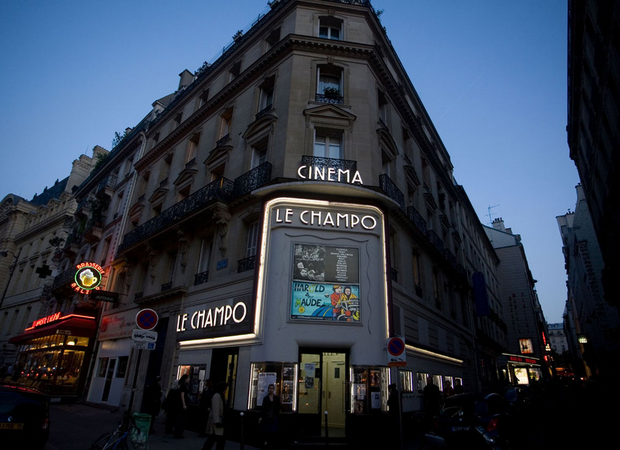
The Moulin Rouge is probably the most famous cabaret in the whole world. Opened in 1889 for the same world’s fair that brought Paris the Eiffel Tower, the Red Windmill has proved it has staying power. However, if we travel back a hundred years, we would see that the legendary cabaret was only one of myriad of nightlife venues of Pigalle and Montmartre. The area became an entertainment hub in the city with its annexation into the borders of Paris in 1860, in fact these venues popped up right on or fringing what had been the former Paris city limits, the Boulevard de Clichy and the BoulevardRochechouart. By the turn of the 20th century, this wide stretch was lined with over 60 cafés, cabarets and dance halls. Bearing names like The Fountain of Love, The Dead Rat and The Weapons of the Abbess (in reference to the former convent in Montmartre), most of these establishments have long since been demolished, however, a few are still around, in one form or another. Join us as we travel back to the Belle Epoque to experience the grand era of Parisian cabarets and see what’s happened to some of the best!

Le Divin Japonais / Le Divin du Monde
Among the few historic Parisian cabarets that still “exist” is this venue sitting just above the boulevard on rue des Martyrs, albeit in a somewhat modified state. The location’s entertainment origins go back to the early 19th century when a dancehall, the Musette de Saint-Flour, was opened here. In the early 1860s this was converted into a brasserie before being transformed yet again in 1873 when it became the Divan Japonais, a concert-bar with, as its name suggests, a Japanese inspired decor. It went on to become one of the most popular hangout during the Belle Epoque, whose spirit was captured in the above poster done by Toulouse-Lautrec in 1893. Reinvented as a theatre in the early 20th century, it later went through a shady period as a cinema house of ill reputed. The venue has since had a sixth life as the nightclub Le Divan du Monde. What’s nice is that its cabaret history has been revived with its sister club, Madame Arthur, found next door. Wednesday through Saturday they do a fabulous twice nightly show with real singers and musicians. In my opinion, it’s the closest cabaret experience to the real ambiance of the Belle Epoque!

La Nouvelle Ève
Another venue pre-dating 1900, this cabaret on rue Pierre Fontaine was first opened as a theatre, the Fantaisies Parisiennes, in 1898. In 1920 it changed hands and became the Gaîté, which premiered the first topless revue in Paris, something which caused quite a stir at the time. During World War II the building was used as a cinema, however, after the war in 1949 it was bought by René Bardy, owner of a cabaret in place Pigalle called Ève, hence this second venue’s name: “The New Ève“. Ever since then it’s been dedicated to cabaret revue shows and provides an alternative to its glitzier, more famous cabaret competitor, the Moulin Rouge, found up the street in Place Blanche.

Cabaret des Truands
A few doors down from the Moulin Rouge, at 100 Boulevard de Clichy, was this more provocative establishment. First opened in 1910 as the Truie qui File (the Pig/Sow who Spins), it went through some other eyebrow raising names until finally settling on the Tavern (or Cabaret) of the Truants. With a name like that you were more than encouraged to misbehave as you entered through its macabre facade and into its equally medieval interiors home to troubadours and alluring damsels. In 1922 it was sold and given a facelift in the new Art Deco style. This is how you’ll still see today as you stand in front of the building, now Le Theatre des Deux Ans (the Two Donkeys Theatre).

Le Chat Noir
On the opposite end of the strip, at 84 boulevard Rochechouart, was one of the most mythical of all Parisian Belle Epoque cabarets: Le Chat Noir. In 1881 the young Rodolphe Salis opened up a Louis XIII style tavern which quickly established itself on the Montmartre nightlife scene. Considered as the first “modern” cabaret, a place combining drinks with singing, music or dance, it grew in renown thanks to performances by local stars like singer Aristide Bruant, who even wrote a song in the cabaret’s honor. The Chat Noir also published a weekly magazine covering literary writings, local cabaret news, poetry, and political satire. The cabaret’s spot in the limelight sadly disappeared along with its owner upon Salis’ death in 1897. Don’t be fooled by the modern café bearing the same name located near the Moulin Rouge, it has nothing to do with the original café besides stealing its name!

Le Ciel et l’Enfer
My absolute favorite of the Belle Epoque cabarets has to be the twin Le Ciel et L’Enfer, Heaven and Hell. Imagine choosing what ambiance you felt like on a give Saturday night in 1900: a little innocent fun in Heaven or an evening of naughtiness in Hell? Located at 53 Boulevard de Clichy, kitty-corner to the Moulin Rouge, the cabarets were opened in 1892 by Antonin Alexander, who upped the ante on the area’s nightlife scene. First time Passers-by of the era must certainly have been left with their mouths as gapping open as that of L’Enfer’s demon entrance. At night the doorman was dressed as a devil who ushered people inside to the slogan of “enter and be damned!”. Forget cancan girls, here the show’s program included “diabolic attractions,” “tormenting the damned,” and “the caldron”… all for the reasonable price of 1.25 francs, and you even got a souvenir to boot! Interestingly, L’Enfer became a hangout of the Surrealists, whose leader André Breton had a studio on the fourth floor of the cabaret’s building. Could the cabaret have inspired their unusual art? Sadly, the cabaret was demolished in the 1950s… to make way for a Monoprix supermarket, which has, on the other hand, stood the test of time.

Cabaret des Incohérents / Café des Décadents
A stone’s throw down the hill from the Moulin Rouge, at 16bis rue Pierre Fontaine, was one of the most weirdest cabarets of the times. Opened in 1884, the Cabaret des Incohérents was known for the “incoherent” shadows it projected on its walls, whose effects were certainly amplified by the era’s beverage of choice, absinthe. In 1894 it was reinvented as the Café des Décadents, which was quickly shut down by the Prefecture due to the indecency of its shows. The next year it reopened with a somewhat modified name, the Café-Concert des Décadents, and a slightly tamer show hosted by an Irish singer who was dressed up as a baby and spent a lot of time caressing a cat she held in her arms (no comment). The famous cancan dancer Jane Avril also graced its stage, bring her following with her, including Toulouse-Lautrec. It changed hands and names a number of times before becoming the Cabaret des Nudistes from 1939 to 1955 (no translation needed) then the Paradise, also a nude cabaret. It was torn down in 1960 and has also been replaced by yet another supermarket, this time a G20.

Le Shanghai
Descending from Place Pigalle is the rue Frochot, a once shady street whose former girly bars have gradually been converted into cool cocktail bars over the last ten years. Few of the evening revelers who overflow from these hip hangouts know that just next to them is one of the neighborhood’s most interesting historical curiosities. Flacking the small square at the end of street is a private mansion built in 1837 and which was once the home a famous 19th century courtesan. In 1920 the lovely building was converted in a cabaret called “Le Shanghai,” when the spectacular art deco stained glass wall, replicating Japanese artist Hokusai’s famous print “The Great Wave off Kanagawa,” was added. Orson Welles is said to have been inspired for his screenplays at the cabaret. In the 1930s it became an “erotic cabaret.” Luckily it hasn’t met the same wrecking ball fate as some of the others. In fact, the stained glass was just restored. You can stop by to have a gander at it while wondering what kind of shenanigans used to go on inside!

Other Cabarets &
Further Neighborhood Explorations
If you’re looking to see a show, there are two other active cabarets in the area. I didn’t highlight them above because one isn’t historic and the other was more of a cafe then real cabaret. Although it goes by the slogan of the oldest “cabaret” in Paris, Au Lapin Agile is a popular photo stop in Montmartre. Located on the other side of the hill to Pigalle, it was one of Picasso’s favorite watering holes. Today it revives its heritage as an “artistic cabaret” with an evening concert-show. Down by the Divan du Monde is Caberet Michou. Opened in 1956, the cabaret sadly lost its charismatic host, Michou, in early 2020, but the show must go on. The cabaret specializes in glitzy drag and is more appropriate for French speaking visitors.
You can learn more about the Golden Age of the era of Cabarets on my tour The Sexy Side of SoPi.
You can also find the above places via our Google Map below and carry on your exploration of the area in these other articles:
Top Romantic Places in the 9th Arrondissement
Top Romantic Places in the 18th Arrondissement
The Revamped Kingdom of Parisian Pleasures (for Playboy.com)





Et Le Rat Mort, suject d’un peinture de Toulouse Lautrec en 1889.
Bonjour James! Oui, le Rat Mort est cité dans l’introduction, cependant, durant ma recherche il me semblait plus un café qu’un cabaret. Fascinant quand-meme!